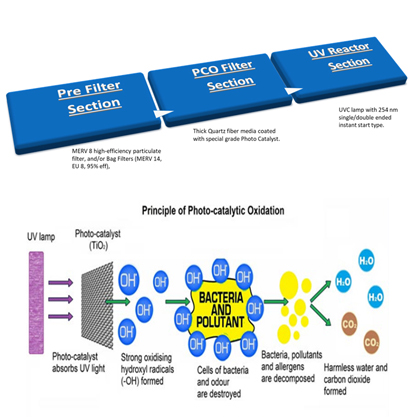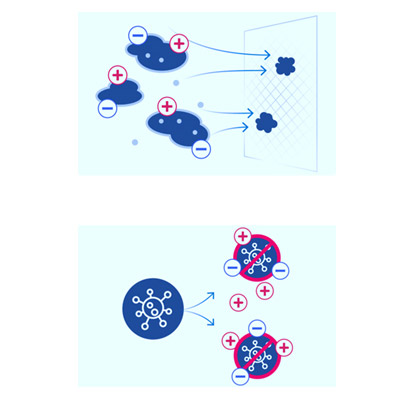Ultraviolet Photocatalytic Oxidation (UVPCO)
Principle Of Operation
UVPCO is installed in buildings to reduce concentrations of volatile organic compounds (VOCs), a large class of air pollutants of concern, it reduces the supply of outdoor air without degrading indoor air quality thus contributing to high energy savings.
UVPCO often utilizes a honeycomb configured, reactor coated with titanium dioxide (TiO2 or Titania) as the photo-oxidative catalyst. This design potentially can have high conversion rates with low pressure drop making it suitable for use in building HVAC systems.
The coated screen is irradiated with UV light near 254 nm UVC. Air containing organic pollutants flows through the screen, where the VOCs adsorb on the catalyst. The UV light interacting with the catalyst in the presence of oxygen and water vapor, produces hydroxyl radicals. Hydroxyl radicals are highly chemically reactive and, in-turn, breakdown the adsorbed VOCs, ideally producing only carbon dioxide and water as by-products.
Feature
- High energy savings
- Suitable for use in building
| Model | CMH |
|---|---|
| EUVPCO – 1 | 3500 |
| EUVPCO – 2 | 7000 |
| EUVPCO – 3 | 10500 |
| EUVPCO – 4 | 14000 |
| EUVPCO – 5 | 17500 |
Premium Quality Products
with Large Sales and Service Network
Most trusted by many
recognised Brands in India
Honored with Recognitions
and Certifications
Brochures & Manuals
You can download the informational brochures or the user manuals for our products






